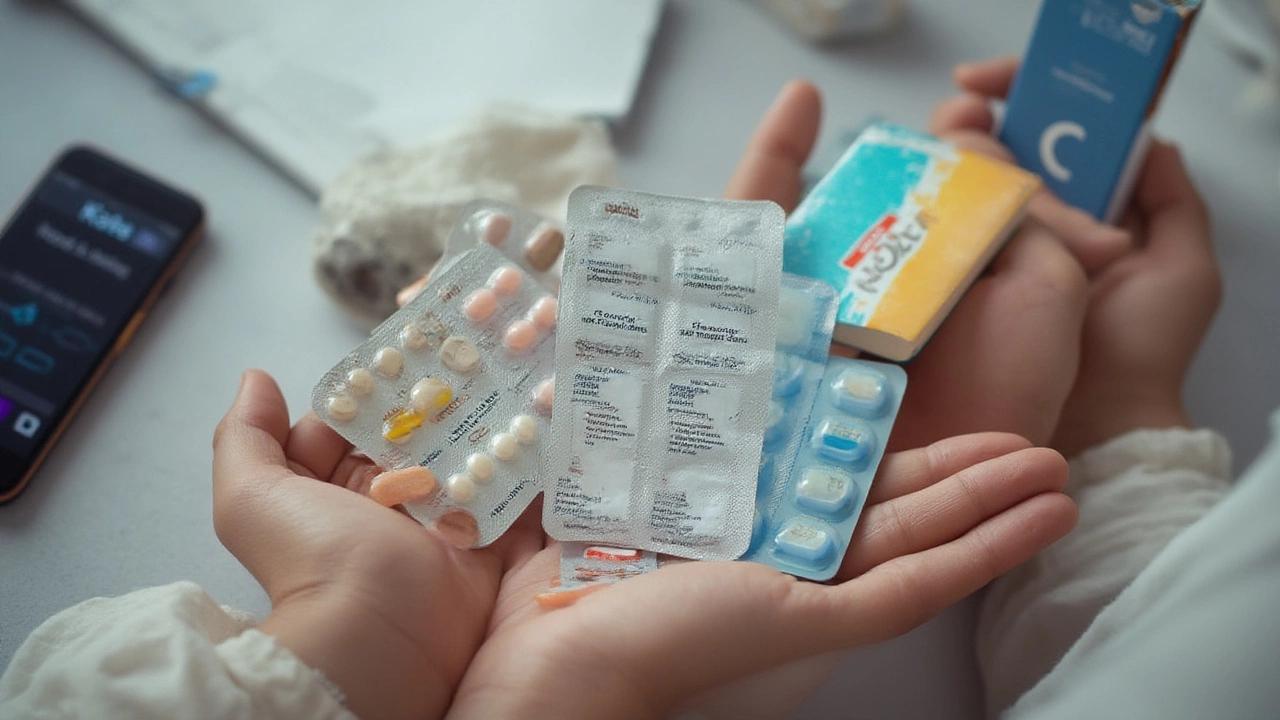
Everybody knows someone who’s been put on metformin. Maybe it’s your cousin, your dad, or even you—after one too many doctor’s visits and some eyebrow-raising blood sugar numbers. But here’s what’s wild: metformin, once the king of type 2 diabetes treatments, is facing some stiff competition. Suddenly, it’s not top dog anymore. People are asking, “Isn’t there something better out there?” In the last few years, the answer has changed from a shrug to a definite yes. Drug companies have been in a sprint, with new medications popping up so fast it’s tough to keep up. Many diabetics today are switching meds, ditching metformin, and seeing better results. So, what’s actually replacing metformin—and does it live up to the hype?
Why Doctors Are Writing Fewer Metformin Prescriptions
Metformin has had a good run. Introduced in the 1950s and approved by the FDA in 1994, it’s been considered a front-line treatment for type 2 diabetes because it’s cheap, safe for most, and usually works well enough. Millions around the world have taken it for decades. But here’s the catch: metformin is not perfect. For one, it doesn’t work for everyone. Some people experience stomach issues—nausea, diarrhea, bloating—that make sticking to it impossible. Others discover it’s not strong enough: their blood sugar stays stubbornly high, or their A1C barely budges unless they’re super strict with their diet. There’s also the worry about its long-term effects on kidney function and vitamin B12 levels, especially for older folks.
Doctors—and patients—have been hungry for better solutions. They’ve been frustrated by metformin’s limitations and some rare but scary risks, like lactic acidosis (usually only with specific conditions but still on people’s minds). At the same time, diabetes rates keep climbing, and so do complications like heart disease and nerve damage. That’s pushed researchers to develop new drugs that do more than just lower blood sugar. In the past five years, there’s been a major shakeup with breakthrough classes like GLP-1 receptor agonists and SGLT2 inhibitors.
GLP-1 receptor agonists, like semaglutide (marketed as Ozempic, Wegovy, and Rybelsus) and liraglutide (Victoza), started to get serious attention when studies showed they do double-duty: not only do they lower blood sugar, but they also curb appetite and promote weight loss. Huge deal, right? Considering extra weight and diabetes go hand in hand, that’s a two-for-one win. Even bigger wow: some of these drugs provide heart protection—reducing the risk of heart attack or stroke. That’s exactly the kind of bonus every diabetic wants.
SGLT2 inhibitors—like empagliflozin (Jardiance) and dapagliflozin (Farxiga)—work differently. They help the kidneys send excess sugar out through urine. What’s cool is the side effects often help, not hinder: a little weight loss, lower blood pressure, and better heart and kidney health for some. The FDA even approved these meds for people with heart failure, diabetic or not. Compare that with metformin, which doesn’t elevate or harm the heart but doesn’t typically make it stronger either.
What also nudged these new meds into the spotlight: they’re given as easy once-weekly injections or daily pills, and many patients say their stomach tolerates them far better than metformin. That’s a life-changer for anyone who’s spent days running for the restroom after their metformin dose.
But why are doctors switching so quickly? Because the research keeps piling up. In 2022 and 2023, massive studies published in the New England Journal of Medicine and JAMA proved that GLP-1s and SGLT2s can actually lower risks of hospitalization, kidney failure, and cardiovascular events—even in people with only mild diabetes. Endocrinologists saw this and basically said, “Why are we still reaching for metformin first?” That attitude is spreading fast.

The Rising Stars: Which Medications Are Taking the Lead?
If you’re hunting for metformin alternatives in 2025, three names come up way more often than any others: semaglutide, tirzepatide, and empagliflozin. Let’s break down what they do and why people are so fired up about them.
First up, semaglutide—the rock star of the diabetes world right now. Originally approved as Ozempic for diabetes and Wegovy for obesity, semaglutide is a GLP-1 receptor agonist. Instead of just helping insulin work better (like metformin), it mimics a hormone in your gut that signals fullness and slows digestion. Trials show A1C drops of 1-2%, and patients can lose anywhere from 10-15% of their body weight if they stick with it. Semaglutide even improves cholesterol and blood pressure numbers for many, which is why doctors recommend it not just for sugar control, but for overall metabolic health.
Tirzepatide (sold as Mounjaro and Zepbound in the U.S.) is the new kid on the block. FDA approvals came in 2022-2023, after clinical trials showed dramatic results: people lost up to 20% of their body weight and saw A1C scores drop like a rock. What sets it apart? Tirzepatide targets two gut hormones instead of one, making it sort of a GLP-1 plus a GIP agonist. That dual action seems to turbocharge weight loss, appetite control, and—no surprise—has made it the most sought-after medication for both diabetes and obesity. Pharmacies have had months-long waiting lists for it.
Then there’s empagliflozin, a frontrunner among the SGLT2 inhibitors. People like it because you just take a pill once daily, and it doesn’t usually cause low blood sugar (hypoglycemia), especially when it’s not combined with insulin or sulfonylureas. What’s really impressive: folks who take empagliflozin and have heart failure or chronic kidney disease see real improvements—lower chances of hospitalization or disease worsening. That puts it head and shoulders above metformin for people whose diabetes has begun to take a toll on their heart or kidneys.
It’s worth noting that for some people—especially those who don’t need to lose weight or are on a tight budget—old-school drugs like sulfonylureas (glipizide, glyburide) and DPP-4 inhibitors (sitagliptin, linagliptin) are still on the menu. But they’re falling out of favor fast, mostly because they don’t protect the heart or help much with weight, and some have more risk for hypoglycemia.
Here’s a handful of tips for anyone considering a switch from metformin: Always talk it over with your diabetes specialist—these newer drugs are expensive, often require prior insurance approval, and side effects (like nausea with GLP-1s or more bathroom trips with SGLT2s) do exist. Start slow and track side effects closely. Some pharmacies have affordable copay plans or card programs, so ask around rather than assuming you can’t afford the fancy new stuff. And while the news is all about injections, many GLP-1s (like Rybelsus) now come in pill form, which can be a huge relief if you’re not a fan of needles.
It’s also worth paying attention to the research around “precision medicine.” Some doctors now use genetic testing or digital algorithms to decide which drug stands the best chance of working for you, based on everything from liver enzymes to how your body absorbs different nutrients. Personalized diabetes care is becoming reality—especially in larger metro hospitals and specialty centers.
Here’s a quick comparison of what sets the top alternatives apart:
- GLP-1 agonists (semaglutide, liraglutide, dulaglutide): Best for weight loss, heart protection, appetite control. Usually an injection, but some pills exist.
- SGLT2 inhibitors (empagliflozin, dapagliflozin, canagliflozin): Great for added kidney and heart protection, especially in older adults. Pill form makes life easy.
- Dual agonists (tirzepatide): Massive effect on weight and sugar. Injection only for now, coverage issues more common.
Metformin still works for lots of people. But if you’re not seeing good results, struggling with side effects, or you’ve got other health issues, there might be something that works better for you now. There’s no shame in switching—especially when the data and your doctor both back it up.

What the Future Holds for Diabetes Medication
Five years ago, nobody expected to see such dramatic changes in diabetes treatment. But here we are, mid-2025, and the pace of innovation isn’t slowing down. Drug companies like Novo Nordisk, Eli Lilly, and AstraZeneca are neck and neck, racing to produce even better meds. There are a few trends, though, that anyone with type 2 diabetes (or who takes care of someone with it) should watch.
First, the race is on to combine the best parts of these drugs into single medications. Already, “combo meds” are appearing in clinical trials—a weekly shot that offers the weight loss of a GLP-1, the blood sugar-lowering of an SGLT2, and heart protection in one fell swoop. Early studies hint these hybrids might let people use lower doses and get fewer side effects, all for better control of diabetes with less hassle. Imagine not juggling a lineup of daily pills—just one shot, done for the week. That’s a big deal for people who feel overwhelmed by all the medication management.
Second, prices might (finally) come down. GLP-1s and SGLT2 inhibitors are notoriously pricey in the U.S.—think several hundred to a thousand bucks per month without insurance. But many of these drugs are going off patent, and generic versions are on the horizon. That means more people could access them, especially across Europe and Asia where governments buy meds in bulk for public health systems. The trick for the U.S. will be insurance coverage and what gets approved for Medicaid and Medicare, but there’s hope costs will be far less of a barrier in the next couple of years.
Third, expect a huge focus on “remission.” Some doctors now talk openly of not just controlling diabetes, but actually reversing it—getting blood sugar low and keeping it there for months or years without drugs. The best chance seems to lie in early, aggressive treatment with these new alternatives, plus major lifestyle changes. People who lose 10-15% of their weight (which GLP-1s and tirzepatide can help with) and stick to a healthy diet can sometimes stop all meds for a while. It's not a cure, but it’s way more optimistic than what was possible even a few years ago.
Other breakthroughs are bubbling up, too. Researchers are studying “oral insulin” and ultra-long-acting shots (think once a month or less). There’s buzz about gene editing, pancreas implants, and even smart insulin pens that connect to your phone. But for now, GLP-1 agonists, SGLT2 inhibitors, and combo agents like tirzepatide are in the spotlight.
Want a tip? Keep your ears open for new clinical trial announcements, and don’t just settle for whatever your first doctor prescribes. Diabetes care is getting personal, and it’s worth asking: “What’s out there that fits me better?” Technology—wearable glucose monitors paired with medication reminders—makes tracking progress easier, and there’s way less guesswork involved. Some clinics even have digital coaches or virtual group visits to keep you on track and motivated.
And about those side effects: they’re usually less intense than many fear, but don’t ignore them. GLP-1 users sometimes feel queasy or experience constipation, mostly at the start. SGLT2 inhibitors can put you at a higher risk of urinary tract infections or, rarely, a dangerous condition called ketoacidosis (mostly if you’re dehydrated). Tirzepatide’s risks are similar to GLP-1s but can include mild hair loss, which surprises some patients. As long as you start slow, keep up with your doctor visits, and stay hydrated, most people find the benefits far outweigh the trade-offs.
What about metformin itself? You’ll see it prescribed less often as new guidelines roll out, but it’s not disappearing. Some people combine a small dose of metformin with the newer drugs to shrink side effects or keep insurance companies happy (they often want to see metformin “failure” first, before approving the expensive stuff). It’s safe, time-tested, and still useful for some. But for many—maybe even you—the diabetes road might soon include something way more modern, effective, and easy to use. The future, frankly, looks pretty bright.





Rohan Talvani
I am a manufacturing expert with over 15 years of experience in streamlining production processes and enhancing operational efficiency. My work often takes me into the technical nitty-gritty of production, but I have a keen interest in writing about medicine in India—an intersection of tradition and modern practices that captivates me. I strive to incorporate innovative approaches in everything I do, whether in my professional role or as an author. My passion for writing about health topics stems from a strong belief in knowledge sharing and its potential to bring about positive changes.
view all postsWrite a comment